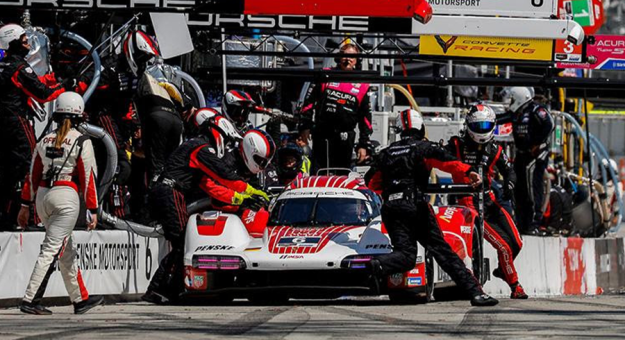DAYTONA BEACH, Fla. — As one of only two 100-minute sprint races on the 2024 IMSA WeatherTech SportsCar Championship calendar, the Acura Grand Prix of Long Beach represents a significant change from the 24- and 12-hour endurance events that traditionally open the season.
Unlike the Rolex 24 At Daytona and the Mobil 1 Twelve Hours of Sebring Presented by Cadillac, competitors aren’t allowed the luxury of time to develop strategies and watch them play out. With less than two hours on the clock – and likely only one pit stop – there’s no time to waste.
That was on clear display on the Long Beach street course last year, when Porsche Penske Motorsport employed a radical strategy that delivered the hybrid-powered Porsche 963 prototype its first victory in international sports car racing competition. Having experienced difficulty getting the car’s tires up to temperature for qualifying – a shared challenge for all Grand Touring Prototype (GTP) class entries at Long Beach last year given cool conditions with temperatures in the lower 60s – the Penske team elected to run the entire race without changing its Michelins.
Nick Tandy started the race from sixth place in the No. 6 Porsche but immediately moved up to second behind the Motul Pole Award-winning No. 10 Wayne Taylor Racing with Andretti Acura ARX-06 when Sebastien Bourdais crashed the No. 01 Cadillac Racing Cadillac V-Series.R at Turn 1, jumbling the field. The two Porsches, with Felipe Nasr in the No. 7, ran second and fifth for the first 30 laps until pit stops started. That’s when the Porsche crews sprung their no-tire-change surprise.
The Porsche pit stops were 10-12 seconds faster than that for the leading Acura, which as expected took on a fresh set of Michelin tires. That elevated Mathieu Jaminet in the No. 6 and Matt Campbell in the No. 7 Porsches into a 1-2 formation, with Ricky Taylor charging after them in the WTRAndretti Acura.
Also as expected, the Porsches lost speed as they experienced tire wear near the end of the race. Taylor forced his way past Campbell into second place, then set off after Jaminet. The Acura caught the No. 6 Porsche with just a handful of laps to go when Jaminet encountered Grand Touring Daytona (GTD) class traffic, setting up a classic finish.
But Taylor misjudged a passing move into Turn 1 and drove into a tire barrier with less than three minutes remaining in the 100-minute contest. The race ended under caution, with Jaminet and the No. 6 Porsche triumphing over the No. 25 BMW M Hybrid V8 driven by Connor De Phillippi and Nick Yelloly. Campbell completed a 1-3 finish for Porsche in the No 7.
The result was hugely significant for Porsche, with the first victory for the Type 963 building on a legacy inspired by the successful 917, 956 and 962 prototypes from decades past.
“The Long Beach race will go down in history as one of the defining moments for our team,” said Jonathan Diuguid, managing director, Porsche Penske Motorsport. “That day in Southern California, we played the strategy game, which was certainly risky, but it paid off. Once the No. 6 car got out in front, the sister car played it perfectly to help defend the lead. That race was the starting point of our run for the IMSA championship and was a monumental moment for the team moving forward. The weekend is something we will never forget.”
Last year’s Long Beach race was important on a more fundamental level because it demonstrated how a well-planned and executed strategy can make all the difference in a WeatherTech Championship race – even one that is just 100 minutes in duration.
“That’s the beauty of sprint races in the IMSA series: There are always many conceivable scenarios, and sometimes a gamble pays off,” said Tandy. “It was clear to us before the start that we couldn’t win the race based on our pace. We didn’t have the fastest car. So, we thought through all possible strategies before race day and agreed not to change the tires. We didn’t know whether the tires would last the distance, but it worked out.”
In 2023, Long Beach was just the third race for each of the GTP class contenders, and all the competing manufacturers and teams were still very much in a learning phase. The cars have been painstakingly developed over the past 12 months for performance and reliability, and a much greater understanding exists now about how to get the best out of tires and the hybrid energy regeneration technology.
